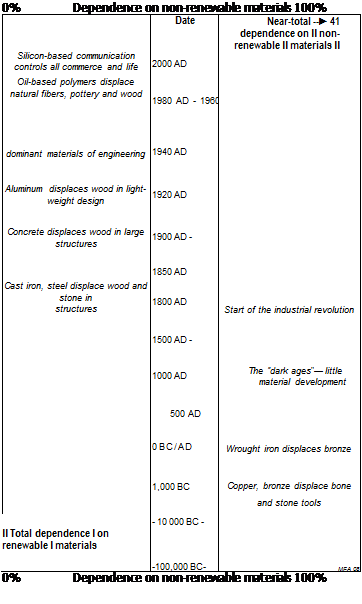All human activity has some impact on the environment in which we live. The environment has some capacity to cope with this impact so that a certain level of impact can be absorbed without lasting damage. But it is clear that current human activities exceed this threshold with increasing frequency, diminishing the quality of the world in which we now live and threatening the well-being of future generations. Part of this impact, at least, derives from the manufacture, use, and disposal of products, and products, without exception, are made from materials.
Materials consumption in the United States now exceeds 10 tonnes per person per year. The average level of global consumption is about eight times smaller than this but is growing twice as fast. The materials (and the energy needed to make and shape them) are drawn from natural resources: ore bodies, mineral deposits, fossil hydrocarbons. the Earth’s resources are not infinite, but until recently, they have seemed so: the demands made on them by manufacture throughout the 18th, 19th, and early 20th centuries appeared infinitesimal, the rate of new discoveries always outpacing the rate of consumption.
 |
The increasing dependence on nonrenewable materials over time, unimportant when they are plentiful but an emerging problem as they become scarce.
![]() This perception has now changed: warning flags are flying, danger signals flashing. The realization that we may be approaching certain fundamental limits seems to have surfaced with surprising suddenness, but warnings that things can’t go on forever are not new. Thomas Malthus,
This perception has now changed: warning flags are flying, danger signals flashing. The realization that we may be approaching certain fundamental limits seems to have surfaced with surprising suddenness, but warnings that things can’t go on forever are not new. Thomas Malthus,
 |
FIGURE 1.3
writing in 1798, foresaw the link between population growth and resource depletion, predicting gloomily that "the power of population is so superior to the power of the Earth to produce subsistence for man that premature death must in some shape or other visit the human race." Almost 200 years later, in 1972, a group of scientists known as the Club of Rome reported their modeling of the interaction of population growth, resource depletion, and pollution, concluding that "if (current trends) continue unchanged… humanity is destined to reach the natural limits of development within the next 100 years." The report generated both consternation and criticism, largely on the grounds that the modeling was oversimplified and did not allow for scientific and technological advance.
But the last decade has seen a change in thinking about this broad issue. There is a growing acceptance that, in the words of another distinguished report: "many aspects of developed societies are approaching… saturation, in the sense that things cannot go on growing much longer without reaching fundamental limits. This does not mean that growth will stop in the next decade, but that a declining rate of growth is foreseeable in the lifetime of many people now alive. In a society accustomed … to 300 years of growth, this is something quite new, and it will require considerable adjustment (WCED (1987))."
The reasons that this roadblock has sprung up so suddenly are complex, but at bottom one stands out: population growth. Examine, for a moment, Figure 1.3. It is a plot of global population over the last 2000 years. It looks
like a simple exponential growth (something we examine in more depth in Chapter 2), but it is not. Exponential growth is bad enough; it is easy to be caught out by the way it surges upward. But this is far worse. Exponential growth has a constant doubling time—if exponential, a population doubles in size at fixed, equal time intervals. The doubling times are marked on the figure. For the first 1500 years it was constant at about 750 years, but after that, starting with the industrial revolution, the doubling time halved, then halved again, then again. This behavior has been called explosive growth; it is harder to predict and results in a more sudden change. Malthus and the Club of Rome may have had the details wrong, but it seems they had the principle right.
Global resource depletion scales with the population and with per-capita consumption. Per-capita consumption in developed countries is stabilizing, but that in the emerging economies, as already said, is growing more quickly. Figure 1.4 shows the distribution of population in the 25 most populous nations containing between them three quarters of the global total. The first two, China and India, account for 37% of the total, and it is these two in which materials consumption is growing most rapidly.
Given all this, it makes sense to explore the ways in which materials are used in design and how this might change as environmental prerogatives
become increasingly pressing. The chapters that follow explore this topic in more depth.



